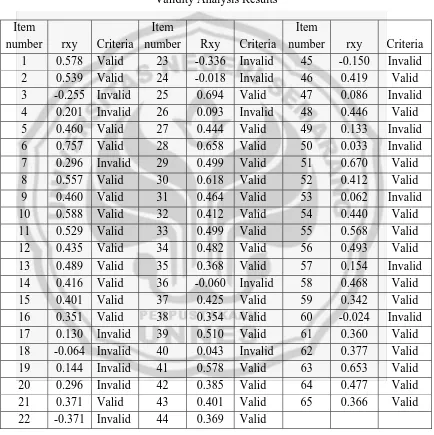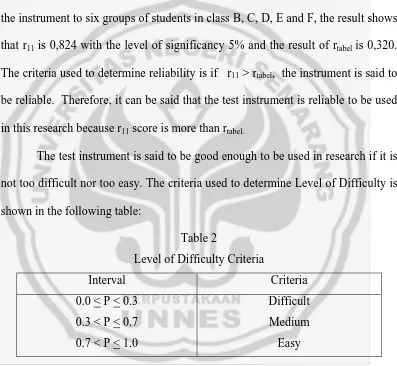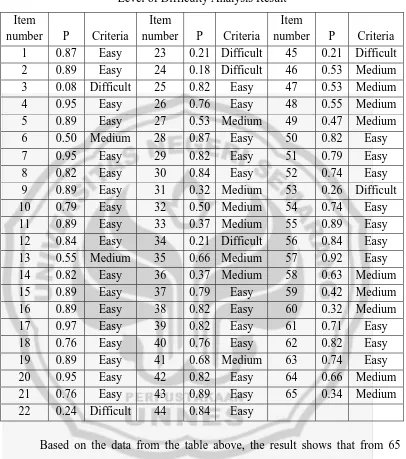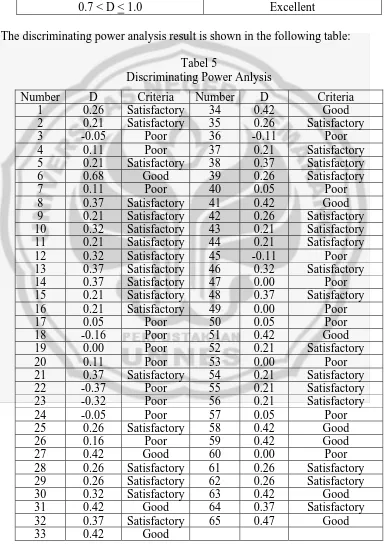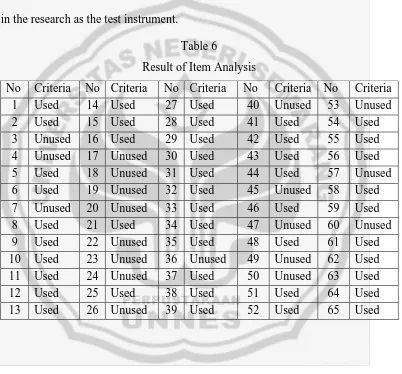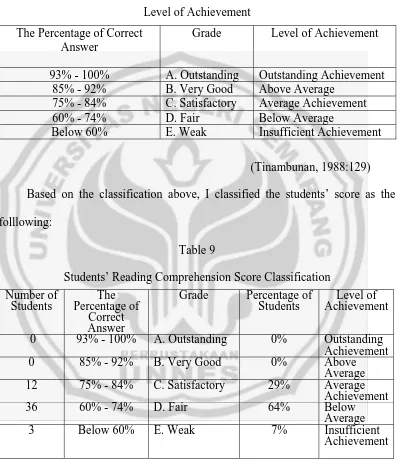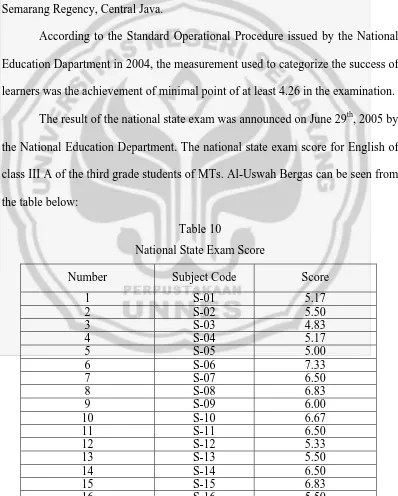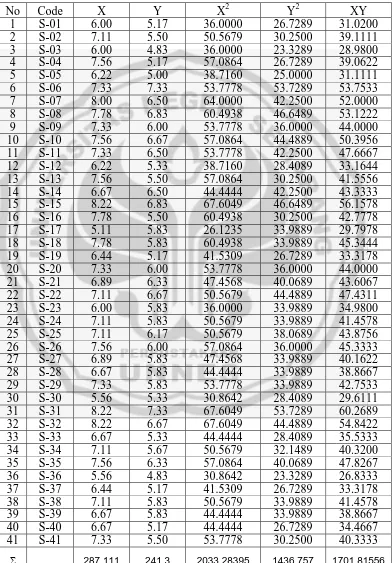THE ABILITY IN COMPREHENDING READING MATERIALS
IN RELATION TO THE FINAL ACHIEVEMENT
OF THE THIRD-GRADE STUDENTS OF MTs. AL-USWAH BERGAS
SEMARANG REGENCY
A Final Project
Submitted in Partial Fullfilment of the Requirements
for the Degree of Sarjana Pendidikan in English
By:
TITIK ISWATI
STUDENT NUMBER: 2201903010
ENGLISH DEPARTMENT
FACULTY OF LANGUAGES AND ARTS
SEMARANG STATE UNIVERSITY
Department of the faculty of Languages and Arts of Semarang State University on ………..
Boards of Examiners 1. Chairperson,
Prof. Dr. Rustono, M.Hum NIP. 131281222
2. Secretary,
Dr. Dwi Anggani LB, M.Pd NIP. 131813665
3. First Examiner,
Dra. Rahayu Puji H, M.Hum NIP. 132158715
4. Second Advisor as Second Examiner, Dra. C. Murni Wahyanti, M.A
NIP. 130805077
5. First Advisor as Third Examiner, Drs. A. Maryanto, M.A., Ph.D NIP. 130529509
Approved by
Dean of faculty of Languages and Arts
Prof. Dr. Rustono, M.Hum
Saya menyatakan bahwa yang tertulis di dalam skripsi ini benar-benar hasil karya saya sendiri, bukan jiplakan dari karya tulis orang lain, baik sebagian atau seluruhnya. Pendapat atau temuan orang lain yang terdapat dalam skripsi ini dikutip atau dirujuk berdasarkan kode etik ilmiah.
Semarang, Januari 2007
To my parents, especially my beloved mother.
First and foremost, I would like to praise Allah SWT, the Almighty, for His boundless love and blessing. I believe that the completion of this Final Project would not be possible without His guidance.
Next, I would like to give my special thank to:
1. Prof. Dr. Rustono, M.Hum, as the Dean of the Languages and Arts Faculty. 2. Drs. Ahmad Sofwan, Ph.D, as the Head of the English Department.
3. Drs. A. Maryanto, M.A., Ph.D, as the first advisor who has guided me patiently from the beginning to the completion of the report. I am sure without such guidance this report would have never been completed.
4. Dra. C. Murni Wahyanti, M.A, as the second advisor, who has helped me in finishing my report.
5. Dra. Sri Haryati Khoiriyah, M.Pd.I, as the Headmistress of MTs. Al-Uswah Bergas, Semarang Regency, who has given the approval to me for conducting research in the school concerned.
6. All lecturers of the English Department of the Languages and Arts Faculty who have guided me during my academic year.
suitable enough to express my gratitude to them.
Last but not least, I would like to thank all of my friends in the English Department especially to all transfer students.
I admit and realize that this final project is not perfect yet and still contains weaknesses. Therefore, I would be glad if criticism and suggestions are given to make this report better. I hope that this report will be useful for the readers and for the improvement of the English learning.
The purpose of this research is to find out the extent to which the students comprehend reading material is and the correlation between the students’ comprehension ability and their national state exam result.
I am interested to choose this problem because reading is one of the skills that students should master in English learning. Besides, this research result would be beneficial for me, as an English teacher, and for the readers.
The population of this research is the third-grade students with total amount of 256 students. The sample chosen is 41 students in class III A. The object of this research is Reading Comprehension Ability and National State Exam.
The data were collected by using an instrument consisting of 65 items of multiple choice reading comprehension questions. The items were tried out to class III B before they were used as a research instrument. After analyzing their validity, reliability, the difficulty level and the discriminating power, 45 items were said to be valid and could be used as a research instrument.
To find out whether or not there is a correlation between reading comprehension ability as a dependent variable and national state exam as an independent variable, Pearson Product Moment Correlation was used. The result shows that 29% of the students obtain average achievement, 64% of the students obtain below average and 7% of the students obtain insufficient achievement in their reading comprehension test. The students’ reading comprehension ability is categorized into fair category for their average achievement point is between 60 – 74. Meanwhile, the national state exam average point is 5,89. It is said that the students have been successful in their national state exam. According to the Standard Operational Procedure from the National Education Department, their success is shown in the score above the passing grade of 4.26 (four point twenty six).
TITLE PAGE ………....i
APPROVAL ……… ………...ii
PERNYATAAN ………...iii
MOTTO …………...iv
DEDICATION ………..v
ACKNOWLEDGEMENT ………..vi
ABSTRACT ………...viii
TABLE OF CONTENT ………..ix
LIST OF TABLES ………..xii
LIST OF APPENDICES ………..xiii
CHAPTER I: INTRODUCTION ………1
1.1. Background of the Study………1
1.2. Reasons for Choosing the Topic ………3
1.3. Statements of the Problems .………...3
1.4. Objectives of the Study ………...4
1.5. Limitation of the Study ………...4
1.6. Significance of the Study ………...4
1.7. Outline of the Study ………...5
CHAPTER II: REVIEW OF THE RELATED LITERATURE ……….7
2.1 Definition of Reading ………8
2.5. Technique of Reading ……….. 11
2.5.1 Sensitizing ………...11
2.5.2 Improving Reading Speed ………....16
2.5.3 From Skimming to Scanning ………...16
2.6. The Definition of Reading Comprehension …………...20
2.7. Level of Comprehension ………..21
2.8. Factors Influencing One’s Comprehension …………...22
2.9. Improving One’s Comprehension ………...23
2.10. Hypothesis ………...26
CHAPTER III: PROCEDURE OF INVESTIGATION ……….27
3.1 Role of the Researcher ……….27
3.2 Procedure of Collecting Data ………....27
3.3 Subject of Investigation ………28
3.3.1 Population ………...28
3.3.2 Sample ………..28
3.4 Variables ………...29
3.5 The Instrument ………..29
3.6 Try-Out ………...29
3.7 Procedure of Analyzing Data ………...30
3.7.4 Discriminating Power ………...33
3.8 Correlation Analysis ………...33
3.8.1 Product Moment Correlation ………...33
CHAPTER IV: DATA INTERPRETATION ………..35
4.1 Statistical Analysis ………...35
4.2 Data Analysis ...40
4.2.1 Reading Comprehension Test Result ...40
4.2.2 National State Exam Result ...43
4.2.3 Correlation of Students’ Reading Comprehension and National State Exam Score ………..…….44
CHAPTER V: CONCLUSION AND SUGGESTION ………47
5.1 Conclusion ………..47
5.2 Suggestion ………...47
BIBLIOGRAPHY ………...49
1. Table 1 Validity Analysis Result ...36
2. Table 2 Level of Difficulty Criteria ...37
3. Table 3 Level of Difficulty Analysis Result ...38
4. Table 4 Discriminating Power Criteria ...39
5. Tabel 5 Discriminating Power Anlysis ...39
6. Table 6 Result of Item Analysis ...40
7. Table 7 Reading Comprehension Score ...41
8. Table 8 Level of Achievement ...42
9. Table 9 Students’ Reading Comprehension Score Classification ...42
10. Table 10 National State Exam Score ...43
1. Research Instrument 2. Validity
3. Reliability
4. Discriminating Power 5. Difficulty Level 6. Correlation
CHAPTER I
INTRODUCTION
1.1Background of the Study
English is regarded as one of the most important and difficult subjects in all grade levels, particularly in junior high schools. It is the first foreign language in our country. Although English has been given since the elementary level, it seems that many students still find difficulties in understanding reading materials in their textbooks as well as in their work sheets.
Building reading ability is an essential goal for teachers at all grade levels. It is important to give more attention to reading than any other skills. Based on the 1994 Curriculum, the four skills of English (listening, speaking, reading and writing) are taught comprehensively. It is generally accepted that reading is believed to be one of the keys to success. Another reason is that reading is the key of knowledge. By reading we can keep up with the development of science and technology.
According to 1994 GBPP (Basic Course Outline), the purposes of teaching reading at the third-grade of junior high schools are described as follows: Students can find or discover
1. certain information from the text
2. the general description of the content of the texts 3. the implicit main ideas of the texts
5. all implicit detailed information of the texts 6. the explicit information of the texts
7. the interpretation of the meaning of a word, a phrase and a sentence based on the context and pleasure from the reading activity
Although the latest curriculum (Competence-Based Curriculum 2004) has been introduced, it is only applied in the first-grade of junior high schools. The 1994 curriculum is still used for it takes times to socialize the new curriculum.
Students’ success in learning English at school is assessed by the results of their national state exam. Here, the assessment of students’ success in English language teaching is assessed by their ability in answering the items to be tested. The students are regarded to be successful in their English if they get good results in their test without considering whether or not those students are able to use English for communicating their ideas. According to the Standard Operational Procedure from the National Education Department, this success is realized by their achievement with the score of at least 4.26 (four point twenty six) in their national state exam.
Generally, the test items of the national state exam include reading comprehension as many as fifty percent of the items to be tested; structure as many as twenty five percent of the items to be tested; and written dialogues as many as twenty five percent of the items to be tested.
comprehend passages properly, he or she will be successful in answering his or her test.
I am interested in analyzing the reading comprehension’s ability of the third-grade level of students of MTs. Al-Uswah Bergas Semarang Regency because when I taught in that school I found that the students’ abilities in the previous years were poor. It could be seen from their achievement in the four language skills based on their test result recapitulation. There were some factors causing that low achievement such as the English teachers that taught at the school were not qualified. It means that those teachers did not graduate from the English Department. Another factor was the students who had low motivation in studying English.
1.2 Reasons for Choosing the Topic
There are two reasons why I chose the topic.
1. First, the curriculum used is 1994 curriculum which required the students to reach the score above the passing grade of 4.26. The ability in mastering the four language skills is important however I really want to know how reading comprehension would influence the students’ success.
1.3Statements of the Problems
From the above description, there are two problems i.e.: 1. To what extent is the students’ ability in reading comprehension?
2. Does the students’ ability in comprehending the passages influence their national state exam result?
1.4 Objectives of the Study
The objectives of this study are:
1. To find out the extent to which students master reading comprehension?
2. To discover the correlation between the students’ mastery in reading comprehension and the examination result?
1.5Limitation of the Study
In this study, I limit my research in reading comprehension. What I mean by the students here are the third-grade level of students of MTs. Al-Uswah Bergas Semarang Regency.
1.6Significance of the Study
The significance of this study can be described as follows: 1. For the students
the students of junior high schools so that those students will be able to improve their ability in learning written English materials. By improving such capability, it is expected that the students will have better understanding of the language, which is realized by their success in doing their tests. Further, they will be able to use the language for communicating their ideas.
2. For the teachers
It is expected that the result of the research would be useful inputs for the teachers of English in teaching learning process especially in teaching reading materials to the students.
3. For Educational System in Indonesia
The result of this study is expected to give a valuable contribution to the development of English teaching in the school concerned.
1.7Outline of the Study
This report consists of five chapters, which can be described as follows: Chapter I deals with the introduction. It includes background of the study, reason for choosing the topic, statement of the problem, objective of the study, limitation of the study, significance of the study, and outline of the study.
Chapter III deals with the procedures of investigation. It includes object of the study, role of the researcher, procedure of collecting data, and procedure of analyzing data.
Chapter IV presents the result of the analysis. This chapter describes the data analysis and the general findings.
CHAPTER II
REVIEW OF THE RELATED LITEARUTE
Harris (1969:59) points out some abilities needed in reading a language which include at least the following:
1. Language and graphic symbols
a. Comprehending a large percentage of lexical items occurring in nonspecialized writing and being able to derive the meaning of unfamiliar items (or special uses of common items) from the contexts in which they occur
b. Understanding the syntactical patterns and morphological forms characteristic of the written language and following the longer and more involved stretches of languages (sentences and sequence of sentences) occurring in formal writing
c. Responding correctly to the graphic symbols of writing (e.g., punctuation, capitalization, paragraphing, italicizing) used to convey and clarify meaning
2. Ideas
a. Identifying the writer’s purpose and central idea
b. Understanding the subordinate ideas which support the thesis
3. Tone and Style
a. Recognizing the author’s attitude toward the subject and the reader; understanding the tone of the writing
b. Identifying the methods and stylistic devices by which the author conveys his idea
2.1 Definition of Reading
Reading is one of the major aspects of language skills, which has a distinctive characteristic, which differentiates it from the other skills. Reading is the core of discussion in the chapters of books, which are used in Junior High Schools and Senior High Schools.
According to Heilman (1981:2) reading is a process of getting meaning from printed word symbols. It is not merely a process of making conventionalized noises associated with these symbols.
Harrison and Smith (1980:8) define reading as the act of responding with appropriate meaning to printed or written verbal symbols. It means that reading is the result of interaction between the graphic symbols that represent the language and the reader’s language skill, cognitive skill and knowledge of words. In this process the reader tries to recreate the meaning intended by the writer. Meanwhile, Chamber and Lowry (in Burns et. al, 1984:11) point out that:
Reading activities needs a process by which people comprehend what they read. That process happens when they face written symbols. They look at them through their eyes, and then their mind will process them. Since then, a process of viewing changes into a process of comprehending. Therefore, this process can be called a cognitive process. Furthermore, Reinking and Scheiner as quoted by Kustaryo (1988:2) suggests that reading is an active cognitive process of interacting with printed or written verbal symbols and monitoring comprehension to establish meaning.
On the other hand, Carrell (1988:12) says that reading is a receptive language process. She adds that it is a psycholinguistic process in that it starts with a linguistic surface representation encoded by a writer and ends with meaning, which the reader constructs.
Bonds (1984:2) states that reading is the recognition of printed or written symbols, which serve as stimuli to recall of meaning built up through the reader’s past experience.
2.2. Component of reading
According to Heilman (1981:241), there are some components of reading. Those components are:
1. Recalling word meanings
2. Drawing inferences from content 3. Following the structure of a passage
4. Recognizing a writer’s purpose, attitude, tone and mood
5. Finding answers to questions answered explicitly or in paraphrase
2.3. Objective of Reading
In general, the objective of reading is classified into various kinds, such as getting the general information of a text, getting the specific information of a text, and reading for interest.
Nurhadi (1987:11) states that the objectives of reading are to understand detailed information from any books, to get the main ideas of any passages, and also to recognize the meaning of words. By understanding the objectives of reading, the reader can get information not only implicitly but also explicitly.
2.4. Importance of Reading
Mikulecky (1986:1) states that reading is important when learning a new language. There are some reasons why reading is important i.e.:
2. Reading helps you to build a better vocabulary
3. Reading makes you more comfortable with written English. You can write better English if you feel comfortable with the language
4. Reading may be the only way for you to use English if you live in a non-English speaking country
5. Reading can help you to plan to study in an English speaking country
Getting students to read in English is vitally important for a number of reasons. Reading is a necessary skill for many, if not all, foreign language learners. Reading in the foreign language is important because it shows the written language in action. Frequent reading exposes students to the language in a way that helps them to acquire the language itself.
2.5. Technique of Reading
Most of the techniques are already familiar to the students in their native language but some students have difficulty in applying them to a second language. Nunan (1981:14-19) as quoted by Grellet defines some reading techniques as follows:
2.5.1 Sensitizing
1. Inference
Inference means making use of syntactic, logical and cultural clues to discover the meaning of unknown elements. If these are words, the word-formation and derivation will also play an important part.
When dealing with a new text, it is better not to explain the difficult words to the learners beforehand. They would only get used to being given “pre-processed” texts and would never make the effort to cope with a difficult passage on their own. On the contrary, students should be encouraged to make a guess at the meaning of the words they do not know rather that look them up in a dictionary. If they need to look the dictionary to get a precise meaning -which is an important and necessary activity too- they should only do so after having tried to work out a solution on their own. This is why, from the very beginning, it is vital to develop the skill of inference.
2. Understanding Relation within the Sentence
3. Linking Sentences and Ideas
Another area in which it is essential to prepare the students is in recognizing the various devices used to create textual cohesion and more particularly the use of reference and link-words.
Reference covers all the devices that permit lexical relationship within a text. It is important for the students to realize that a text is not made up of independent sentences or clauses, but it is a web of related ideas that are announced, introduced and taken up again later throughout the passage with the help of reference.
If the reader does not understand some words of the passages, some of the facts and ideas will probably escape him. But if he does not understand inter – or – intra sentential connectors, he may also fail to recognize the communicative value of the passage since those words act as signals indicating the function of what follows.
2.5.2 Improving Reading Speed
Students who read too slowly will easily get discouraged. They will also tend to stumble on unfamiliar words, and fail to grasp the general meaning of the passage.
2.5.3 From Skimming to Scanning
one’s reasons for reading. Students will never read efficiently unless they can adapt their reading speed and techniques to their aim when reading. By reading all texts in the same way, students would waste time and fail to remember points of importance to them because they would absorb too much non-essential information.
Nunan suggests some ways below as cited by Grellet to make the students more confidents and efficient readers:
1. Predicting
This is not really a technique but a skill, which is basic to all the reading techniques (practiced in this part) and to the process reading generally. It is the faculty of predicting or guessing what is to come next, making use of grammatical, logical and cultural clues. This skill at the core of techniques such as “anticipation” or “skimming” and will therefore be practiced in those sections, but it may be worthwhile to devote some time to more systematic training by giving the students unfinished passages to complete or by going through a text little by little, stopping after each sentence in order to predict what is likely to come next.
2. Previewing
3. Anticipation
Motivation is of great importance when reading. Partly because most of what we usually read (book, advertisement, magazine, etc), but also because being motivated means that we start reading the text prepared to find a number of things in it, to find answers to a number of questions and specific information or ideas we are interested in. This “expectation” is inherent in the process of reading which is a permanent interrelationship between the reader and the text. What we already know about the subject and what we are looking for are probably just as important as what we actually draw from the text. When reading, we keep making prediction, which, in turn, will be confirmed or corrected.
This underlines the artificiality of the classroom situation in which students are often confronted with passages they know nothing about, do not and cannot situate in a more general cultural context. It is even more important to have more particular desire to read. It is very difficult, in such conditions, to expect the students to learn to read better.
text, they can always be asked to look for the answers to specific questions. This will give an incentive to their reading activity.
4. Skimming and Scanning
Both skimming and scanning are specific reading techniques necessary for quick and efficient reading. When skimming, we get through the reading material quickly in order to get the gist of it, to know how it is organized, or to get an idea of the tone of the intention of the writer.
2.6. The Definition of Reading Comprehension
Jarolimek (1985:243) states that reading with comprehension means that the reader is able to extract from the selection its essential facts and understandings, visualize details and sense the readiness of facts.
From the statement above, we know that reading with comprehension is not only reading the selection but also trying to comprehend or understand the message in the selection. One indication that the reader already comprehends the selection is he/she can answer the questions based on the selection.
Jarolimek (1985:244) points out that reading comprehension is social studies consisting of at least four components:
1. Getting the literal meaning or a general understanding of what is being communicated.
2. Understanding and remembering facts and details that support the idea. 3. Recognizing and remembering the sequence of ideas or event presented 4. Following direction.
All of the four components above show that in reading comprehension the readers have to understand and remember the author’s idea in the selection and try to find the supporting details that support the ideas.
Since it is also hard to definitely define reading comprehension, some linguists define it differently, but Kustaryo (1988:11-12) almost has the same opinion as Zorn concerning the definition of reading comprehension. She states that reading with comprehension means understanding what has been read. It is an active thinking process that depends not only on comprehension skills but also on the student’s experiences and prior knowledge. Reading comprehension itself is a process of making sense of written ideas through meaningful interpretation and interaction with the language (Heilman, 1981:242).
Harris (1981:479) defines comprehension ability as a set of generalized knowledge acquisition skills, which permit people to acquire and exhibit information gained as a consequence of reading printed language.
2.7. Level of Comprehension
By knowing the level of comprehension, the weaknesses of the readers can be found; therefore, it will help both the teachers and the learners. According to Burns, et al. (1984:177), there are four levels of comprehensions:
1. Literal Reading
2. Interpreting Reading
Interpreting reading involving reading between the lines or making inferences is the process of deriving ideas, which are implied, rather than directly stated. At this level, the reader is able to understand what the author meant.
3. Critical Reading
Critical reading is evaluating written material- comparing the ideas discovered in the material which is known standards and drawing conclusion about their accuracy, appropriateness. Critical reading depends upon literal comprehension and interpretive comprehension and gasping ideas is especially important.
4. Creative Reading
Creative reading involves going beyond the material presented by the authors. It requires readers to think as they read, just as critical reading does, and it also requires them to use their imagination.
2.8. Factors Influencing One’s Comprehension
Nuttal (1982:5) says there are many factors that can make a text difficult to be understood by the readers. Some factors making a text difficult to be understood are:
1. The difference code between the writer and the reader
communication. So, one of the prerequisites for satisfactory communication is that the writer and the reader should share the same code.
2. The lack of the reader’s previous knowledge about science
A text is difficult to the reader who knows nothing about science. Although he/she will find some of the difficult words in a dictionary, it will not help him/her to understand the definition. So, the reader’s previous knowledge is important in understanding a text.
3. The limited of reader’s vocabulary
The reader finds a text difficult because his/her vocabulary is limited. He/she cannot translate a text into extremely simple English and the message is not challenging intellectually.
2.9. Improving One’s Comprehension
One important factor that influences the students’ reading comprehension achievement is vocabulary mastery. Vocabulary is one of the important causes of poor reading comprehension and faulty reading. Most students cannot understand articles or textbooks because their vocabulary is very limited. For this reason, the teacher should help the students to improve their vocabulary.
According to Langan’s (1994:30), there are some ways, which can be used to improve students’ vocabulary:
1. Context Clue
students to memorize those words. The better way can be used by using context clues. There are some advantages of using context clues. Those advantages are described as follows:
a. It will save our time when we are reading, we will not have to stop to look up words in the dictionary.
b. It will improve our understanding of what we read because we will know more of the words
c. It will expand our vocabulary. 2. Using the dictionary
Using the dictionary to determine a word’s meaning is more difficult for the young student than an adult may suppose. When students use dictionary, make sure that they know how to use the dictionary. Among the skills one must teach according to Evelyn Jan Tausech (in Clark and Starr, 1981:229) are the following:
The secondary student should be able to recognize alphabetical sequence, use guide words, identify root word in both inflected and derived forms, select the definition that fits the context and realize the differing purposes of comma and semicolon as used in dictionary meaning. He should be capable of using the pronunciation key: the etymology key and responding correctly to the accent work. He should know that geographical and biological information could be located in some dictionaries and understanding the limited nature of this information so that he uses it appropriately.
(1) The definition may include words student does not understand (2) There are many words having more than one meaning listed for them (3) The difficulty to remember the new words.
We can use the dictionary as the last resort when puzzle or to confirm what we have already guessed. In using the dictionary, the teacher should point out to the students how to use the dictionary effectively, so they will become skillful in its use.
From the above description, we know that using context clues is more effective than using dictionaries. It means that new words and terms should be presented and developed in the context of a phrase or a sentence rather than in isolation.
2.10. Hypothesis
From the description above I conclude a hypothesis that:
CHAPTER III
PROCEDURE OF INVESTIGATION
This research is descriptive research. According to Sax’s (1979:75) descriptive research is research involving the collection of data for the purpose of describing existing data. Further explanation about descriptive research is proposed by Best (1981:25) who states that the descriptive research describes what it is. It involves the description, recording analysis, and interpretation of conditions that exist. It involves some types of comparison and contrast and attempt to discover relationship between non-manipulated variables.
3.1Role of the Researcher
The role of the researcher in this report is to investigate the level of ability of the third grade students of MTs Al-Uswah Bergas Semarang Regency in comprehending reading materials and the correlation between the reading comprehension ability and the students’ final achievement. The researcher would like to know whether or not the students’ reading comprehension ability has a significance contribution to their final test achievement that the result of the research would be a beneficial input to the English teaching in general.
3.2Procedure of Collecting Data
To find out the data of the ability of students’ reading comprehension, I have administered a reading comprehension test to the third grade students of MTs Al-Uswah Bergas Semarang Regency in the academic year 2004/2005. 2. Documentary research
To find out the data of national examination result, I took the data from the school concerned.
3.3Subject of Investigation
3.3.1 Population
Best (1981:8) defines population as group of individuals that has one or more characteristics in common that is of interest to the writer. The population may be all the individuals of a particular type or a more restricted part of that group. The population of this report was the students of the third-grade of MTs. Al-Uswah Bergas Semarang Regency. Those students were classified into six classes, which were IIIA, IIIB, IIIC, IIID, IIIE, and IIIF. The total students of the third-grade of MTs Al-Uswah Bergas in the academic year 2004/2005 were 256 students.
3.3.2 Sample
the population used as the sample. If the population is homogenous enough and the number of the population is less than 100, we can take about 20%-25%.
I chose class IIIA as a sample to be the representative of the population because these students have represented the whole population. The numbers of the students of the class concerned were forty-one students.
3.4Variables
A variable is a characteristic that takes on different values or conditions for different individuals (Wiersma, 1991:25). There are two variables in this study. Those variables are: a. Reading comprehension ability as an independent variable, and
b. Students’ national state exam result a dependent variable.
3.5The Instrument
An instrument plays an important role in a research. Heaton (1975:1) says that test may be constructed primarily as device to reinforce learning and to motivate the students or primarily as a means of assessing the students’ performance in the language.
3.6Try-Out
3.7Procedure of Analyzing Data
3.7.1 Validity of the Test
I used content validity I wanted to measure the students’ reading comprehension ability. In line with the issue, Moore (1983:212) asserts that content validity is most useful with intelligence, ability, achievement and skill, and proficiency test.
Ary (2004:296) as quoted by Furchan states that the researcher should compose the test, which is used as an instrument in the research, by consulting to the experts in order for the test or the instrument to be valid.
I took the following considerations before constructing the items of reading comprehension test.
1. Consulting the GBPP (Basic Course Outline) in selecting the items to be tested in the research. The test items involved the materials of reading comprehension related to those mentioned in the Basic Course Outline.
2. Consulting the first and second adviser before constructing the test items. 3. Choosing the appropriate topics of the passages based on the curriculum used
in order for the instrument to cover all the reading material items taught in the third-grade of junior high schools.
Besides using content validity, I used empirical validity by administering try-out in my research. To find out the validity, I used this formula:
in which:
rxy = correlation coefficient
N = number of students x = total of item score y = total of the score
3.7.2 Reliability of the Test
Heaton (1984:155) says that reliability is also an essential characteristic of a good test. Meanwhile, Gay and Dielhi as quoted by Sigit (2003:146) define that reliability is the ability to measure without any mistakes and the result will always be consistence although the test is used by other people in different places. Gay and Dielhi say that reliability means consistency, dependability and trustworthiness.
Reliability has to do with the result. It means that the examinee will always find approximately the same result if the same test is given to the same examinee in different occasions, different places and if the answer sheets are graded by different people.
Reliability can be measured by using K-R 21 formula as folows:
( )
r11 : instrument reliability
k : total item to be tested M : total score average Vt : total varians
Y : total score
n : number of students
3.7.3 Level of Difficulty
The difficulty index or the facility value of an item shows how easy or difficult the item proved in the test. Analysis of difficulty level is intended to select the items that have a good level of difficulty. An item is said to have a good level of difficulty if it is not too easy or too difficult. This formula was used to compute the value of level of difficulty:
Js B P=
(Arikunto, 2005:208)
in which:
P = the level of difficulty
JS = the total number of the students
3.7.4 Discriminating Power
Analysis of discriminating power is important to distinguish the high and low achievers. Heaton (1975:157) states that the discrimination of the test is its capacity to discriminate among the different candidates and to reflect the differences in the performance of the individuals in the group.
The discriminating power of the items was measured by using this formula:
D = the discrimination index
BBA = the number of students in upper group who answered the item correctly
BBB = the number of students in lower group who answered the item correctly
JA = the number of students in upper group
JB = the number of students in lower group
3.8 Correlation Analysis
3.8.1 Product Moment Correlation
English. According to the Standard Operational Procedure from the National Education Department, this success was realized by their achievement with the score of at least 4.26 (four point twenty six) in their national state exam. I assumed that if the students’ comprehension towards passages in English was good, they would be successful in their test. This assumption was based on the fact that the majority of the test items were dominated by passages or texts.
The estimation above was proved by using the formula called Product Moment Correlation, which studied the relationship between these two variables. I used this formula to calculate the relationship of X that represented the students’ reading comprehension ability to Y that represented the students’ final achievement, which was symbolized by r.
( )( )
rxy = correlation coefficient
N= the number of students x = independent variable score y= dependent variable score
If rxy > rtabel meant that the hypothesis, stating that there was a relationship
CHAPTER IV
DATA INTERPRETATION
Reading comprehension, which is one skill of the four language skills in English, is regarded as a significant skill that should be mastered by those who learn English. In my opinion, secondary students need to master this skill, considering reading comprehension is one of the skills tested in the national state exam. I assume that the students’ reading comprehension ability could influence their achievement in the final examination.
Regarding the importance of mastering reading comprehension, I conducted a test for I wanted to know the extent to which students’ master reading comprehension and if there is a correlation between their comprehension ability with their achievement in doing their test.
To answer those two questions, I conducted research to prove my assumption that there is a correlation between students’ reading comprehension ability with their examination results.
I did a series of steps in my research and the result of the research is described as the following:
4.1 Statistical Analysis
difficulty and if that instrument could distinguish high and low achievers, before it was given to the sample of the research.
The result of the validity analysis can be seen in the following table: Table 1
number rxy Criteria 1 0.578 Valid 23 -0.336 Invalid 45 -0.150 Invalid 2 0.539 Valid 24 -0.018 Invalid 46 0.419 Valid 3 -0.255 Invalid 25 0.694 Valid 47 0.086 Invalid 4 0.201 Invalid 26 0.093 Invalid 48 0.446 Valid 5 0.460 Valid 27 0.444 Valid 49 0.133 Invalid 18 -0.064 Invalid 40 0.043 Invalid 62 0.377 Valid 19 0.144 Invalid 41 0.578 Valid 63 0.653 Valid 20 0.296 Invalid 42 0.385 Valid 64 0.477 Valid 21 0.371 Valid 43 0.401 Valid 65 0.366 Valid 22 -0.371 Invalid 44 0.369 Valid
subject 38 that is 0,320, so that those twenty items are said to be invalid. The forty five valid items can be used as the research instrument; they are numbers 1, 2, 5, 6, 8, 9, 10, 11, 12, 13, 14, 15, 16, 21, 25, 27, 28, 29, 30, 31, 32, 33, 34, 35, 37, 38, 39, 41, 42, 43, 44, 46, 48, 51, 52, 54, 55, 56, 58, 59, 61, 62, 63, 64 and 65.
Besides having validity, the instrument is reliable because after I tried out the instrument to six groups of students in class B, C, D, E and F, the result shows that r11 is 0,824 with the level of significancy 5% and the result of rtabel is 0,320.
The criteria used to determine reliability is if r11 > rtabel, the instrument is said to
be reliable. Therefore, it can be said that the test instrument is reliable to be used in this research because r11 score is more than rtabel.
The test instrument is said to be good enough to be used in research if it is not too difficult nor too easy. The criteria used to determine Level of Difficulty is shown in the following table:
Table 2
Level of Difficulty Criteria
Interval Criteria 0.0 < P < 0.3
0.3 < P < 0.7 0.7 < P < 1.0
Difficult Medium
Easy
Table 3
Level of Difficulty Analysis Result Item
number P Criteria Item
Based on the data from the table above, the result shows that from 65 items to be tested, there are 40 easy items, 18 items with medium level of difficulty and 7 difficult items.
Table 4
The discriminating power analysis result is shown in the following table: Tabel 5
Discriminating Power Anlysis
Number D Criteria Number D Criteria
1 0.26 Satisfactory 34 0.42 Good
2 0.21 Satisfactory 35 0.26 Satisfactory
3 -0.05 Poor 36 -0.11 Poor
4 0.11 Poor 37 0.21 Satisfactory
5 0.21 Satisfactory 38 0.37 Satisfactory
6 0.68 Good 39 0.26 Satisfactory
7 0.11 Poor 40 0.05 Poor
8 0.37 Satisfactory 41 0.42 Good
9 0.21 Satisfactory 42 0.26 Satisfactory 10 0.32 Satisfactory 43 0.21 Satisfactory 11 0.21 Satisfactory 44 0.21 Satisfactory
12 0.32 Satisfactory 45 -0.11 Poor
13 0.37 Satisfactory 46 0.32 Satisfactory
14 0.37 Satisfactory 47 0.00 Poor
15 0.21 Satisfactory 48 0.37 Satisfactory
16 0.21 Satisfactory 49 0.00 Poor
17 0.05 Poor 50 0.05 Poor
18 -0.16 Poor 51 0.42 Good
19 0.00 Poor 52 0.21 Satisfactory
20 0.11 Poor 53 0.00 Poor
21 0.37 Satisfactory 54 0.21 Satisfactory 22 -0.37 Poor 55 0.21 Satisfactory
28 0.26 Satisfactory 61 0.26 Satisfactory 29 0.26 Satisfactory 62 0.26 Satisfactory
30 0.32 Satisfactory 63 0.42 Good
31 0.42 Good 64 0.37 Satisfactory
32 0.37 Satisfactory 65 0.47 Good
From the table, the result shows that twenty items fall under poor category for D < 0, 20. Those items are numbers 3, 4, 7, 17, 18, 19, 20, 22, 23, 24, 26, 36, 40, 45, 47, 49, 50, 53, 57 and 60.
According to the analysis of the validity, reliability, level of difficulty and discriminating power, there are 45 items which meet the requirements to be used in the research as the test instrument.
Table 6
Result of Item Analysis
No Criteria No Criteria No Criteria No Criteria No Criteria 1 Used 14 Used 27 Used 40 Unused 53 Unused
4.2.1 Reading Comprehension Test Result
Table 7 Reading Comprehension Score
Reading Comprehension Number Subject Codes
Total Items Correct Score
This classification is used to measure the students’ reading comprehension level of achievement:
Table 8
Level of Achievement The Percentage of Correct
Answer
Grade Level of Achievement
93% - 100% A. Outstanding Outstanding Achievement 85% - 92% B. Very Good Above Average
75% - 84% C. Satisfactory Average Achievement 60% - 74% D. Fair Below Average
Below 60% E. Weak Insufficient Achievement
(Tinambunan, 1988:129)
Based on the classification above, I classified the students’ score as the folllowing:
Table 9
Students’ Reading Comprehension Score Classification Number of
Students Percentage of The Correct Answer
Grade Percentage of
Students AchievementLevel of 0 93% - 100% A. Outstanding 0% Outstanding
4.2.2 National State Exam Result
The national state exam for the secondary students in the academic year 2004 / 2005 was administered on Monday, June 6th, 2005 until Wednesday, June 8th, 2005 from 07.30 a.m until 09.30 a.m. The location of the test was in MTs. Al-Uswah Bergas, located on Jalan Masjid Tegalsari, Bergaslor Subdistrict, Semarang Regency, Central Java.
According to the Standard Operational Procedure issued by the National Education Dapartment in 2004, the measurement used to categorize the success of learners was the achievement of minimal point of at least 4.26 in the examination. The result of the national state exam was announced on June 29th, 2005 by the National Education Department. The national state exam score for English of class III A of the third grade students of MTs. Al-Uswah Bergas can be seen from the table below:
Table 10
National State Exam Score
Number Subject Code Score
17 S-17 5.83
The average point of forty-one students in the final examination is 5.89, meaning those students do not fail in their examination.
4.2.3 Correlation Result of Students’ Reading Comprehension and National
State Exam Scores
The computation of the correlation analysis is as the following Table 11
Correlation Result of
Students’ Reading Comprehension and National State Exam Scores
41
41 2 41 1436.76 241.3 2
r x y =
1701.82 287.111 241.3
2033.28 287.111
Forα= 5% and number of subject 41, r table = 0.308.
The hypothesis stating that there is a correlation between reading comprehension ability and students’ national state exam result, can be accepted. Since rxy > rtable, it is stated that there is a correlation between reading
CHAPTER V
CONCLUSION AND SUGGESTION
5.1. Conclusion
Students need to have a good mastery in the four language skills. Reading comprehension is included in the four language skills that must be mastered by those students. It is advantegeous to have a good comprehension of passages in English because reading is the core of discussion in the chapters of books, which is used in junior and senior high schools according to the 1994 curriculum. Moreover, the national state exams based on the 1994 curriculum emphasized the test materials on reading comprehension.
After teaching in MTs. Al-Uswah Bergas for some years, I had an assumption that the students’ ability in comprehending English texts was categorized into poor category. This result could be seen from the score recapitulation of the students in the previous academic years. There were some factors that caused that poor achievement. First factor was the quality of the teachers of English. Some English teachers in the school did not graduate from the English department therefore they did not master the subject well. Second factor was the students in the school had low motivation in English because they regarded English as a very difficult subject. Third factor was the limit number of books used.
I conducted research in 2005 for the students in the academic year 2004/2005. I gave reading comprehension multiple choices questions which relevant to the Basic Course Outline (GBPP) and 1994 curriculum.
The result shows that the students’ ability in this academic year was categorized into fair category. This achievement influences their national state exam score. Students who have a good ability in comprehending English texts will have a good achievement in their English test for they know and understand what is written in the text. This understanding makes them easier to answer the questions from the text material.
5.2 Suggestion
There are some factors to improve the students’ ability in learning English at MTs. Al-Uswah Bergas Semarang Regency i.e.:
1. The school must have qualified teachers. What I mean by qualified teachers are teachers who are from the English department so that they master English materials and curriculum. These teachers must also be able to transfer their knowledge to the students.
2. The school needs to provide good books that correspond to the required curriculum.
For secondary students in general, motivation from teachers and themselves is a key and an important thing to do to get better understanding in comprehending English texts. Besides, some steps below may be beneficial to improve their comprehension:
1. Teachers provide interesting reading materials that relevant to the curriculum. 2. Students improve their vocabulary by reading English texts more and try to
find the difficult words by using dictionary.
3. Besides, students should enrich their knowledge by reading more books in their native language.
:
BIBLIOGRAPHY
Arikunto, Suharsimi. 2005. Dasar-Dasar Evaluasi Pendidikan. Jakarta: Bumi Aksara.
Arikunto, Suharsimi. 2002. Prosedur Penelitian Suatu Pendekatan Praktik. Yogyakarta: Rineka Cipta.
Best, John W. 1981. Research in Education. Englewood, USA: Prentice Hall Inc. Bond, Guy L., Miles A. Tinker, Barbara B. Wasson. 1984. Reading Difficulties:
Their Diagnosis and Correlation. Jersey: Prentice-Hall. Inc.
Burns, C.P., Roe, D.P., & Ross, B.E. 1984. Teaching Reading in Today’s
Elementary School. Boston: Houghton Mifflin Company.
Carrell, Patricia L. 1988. Interactive Approaches to Second Language Reading. Cambridge: Cambridge University Press.
Clark, L.H. & Starr, L.S. 1981. Second and Middle School Teaching Methods. New York: Macmillan Publishing.
Depdikbud, 1995. Kurikulum Sekolah Lanjutan Tingkat Pertama: Garis-garis
Besar Program Pengajaran. Jakarta: Departemen Pendidikan dan
Kebudayaan Direktorat Jenderal Pendidikan Dasar dan Menengah.
Furchan, Arief. 2004. Pengantar Penelitian Dalam Pendidikan. Yogyakarta: Pustaka Pelajar.
Grellet, Francois. 1981. Developing Reading Skills. A practical guide to reading
comprehension exercises. Cambridge: Cambridge University Press.
Harris, Albert, J. 1981. How to Increase Reading Ability. New York: Longman Inc.
Harrison, C. and F. Smith. 1980. Reading Instruction. New York: Owen Publishers. Inc.
Heaton, J.B. 1975. Writing English Language Test. London: Longman Group Ltd. Heilman, Arthur W. 1981. Principles and Practices of Teaching Reading. U.S.A.:
Jarolimek, J. 1985. Social Studies Elementary Education. Pennsylvania: Macmillan Publishing Company.
Kustaryo, Sukirah, Dra. 1988. Reading Techniques for College Students. Jakarta: Proyek Pengembangan Lembaga Pendidikan Tenaga Kependidikan. Direktorat Jenderal Pendidikan Tinggi, Depdikbud.
Lado, Robert. 1976. Language Teaching. A Scientific Approach. New Delhi: Tata Mc.Graw-Hill Publishing Ltd.
Langan, J. & Broderick, B. 1994. Ten Steps to Building College Students. Townsend.
Mikulecky, B. S. 1986. Reading Power. Massachusetts: Addison Wesley Publishing Company.
Moore, Gary W. 1983. Developing and Evaluating Educational Research. Boston: Little Row and Company.
Nawawi, Hadari.1983. Metode Penelitian Bidang Sosial. Yogyakarta: Gadjah Mada Press.
Nurhadi. 1987. Membaca Cepat dan Efektif. Bandung: Sinar Baru
Nuttal, Christine. 1982. Teaching Reading Skill in a Foreign Language. London: Parkway Group.
Sax, Gilbert. 1979. Foundation of Educational Research. Englewood Cliff, New Jersey: Prentice Hall Inc.
Tinambunan, Wilmar. 1988. Evaluation of Student’s Achievement. Jakarta: Depdikbud.
